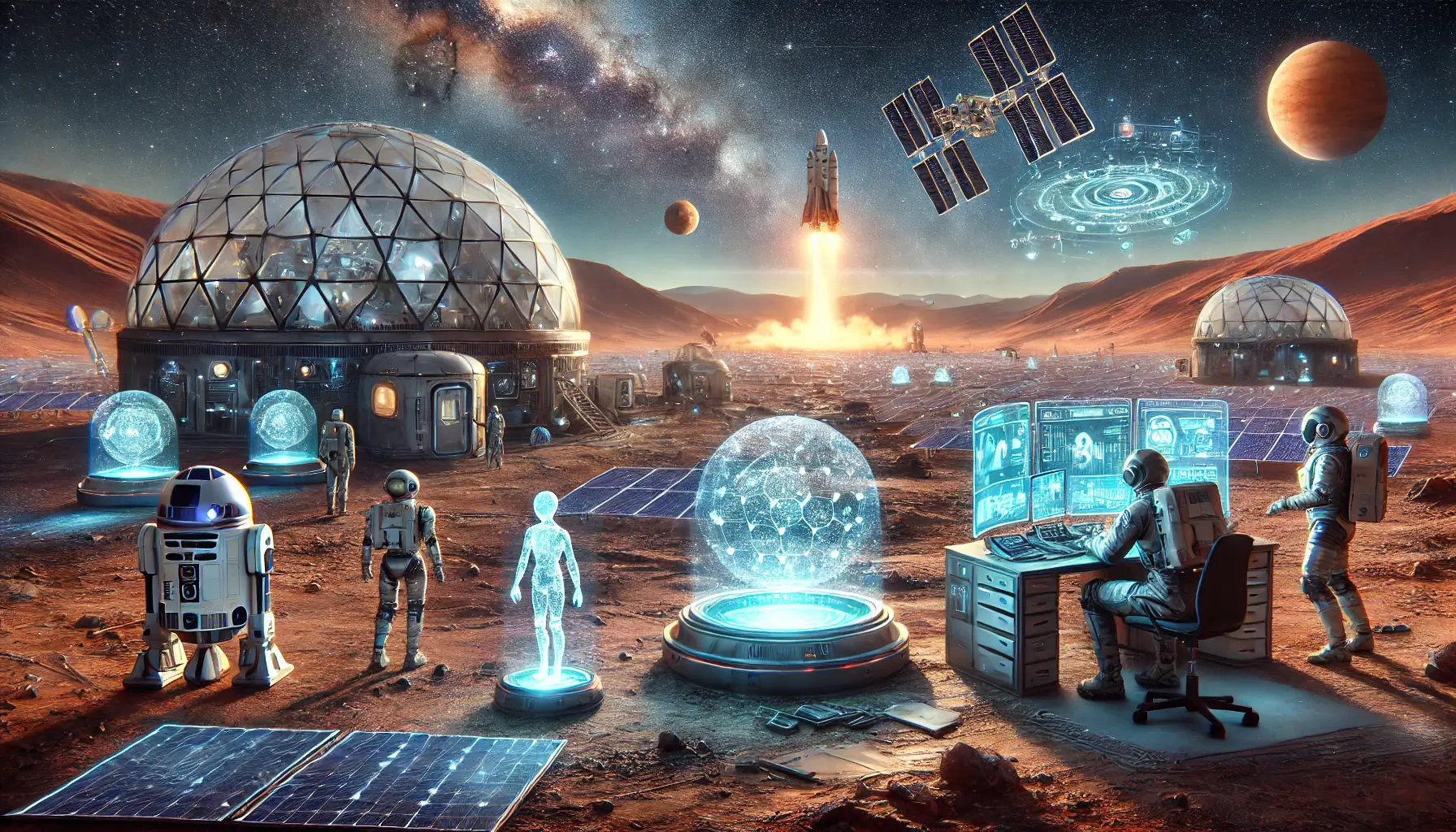-
How Digital Nomads Are Redefining Work and Lifestyle 🌍💻
Mar 06, 2025 | 39 Comments -
How Artificial Intelligence is Transforming Healthcare 🏥🤖
Mar 06, 2025 | 0 Comments -
How Cryptocurrency is Reshaping the Global Economy 💰🌍
Mar 06, 2025 | 0 Comments -
How to Build a Strong Personal Brand: Stand Out & Grow Your Influence 🚀📢
Mar 02, 2025 | 0 Comments -
The Power of AI in Business: How Artificial Intelligence is Transforming Industries 🚀🤖
Mar 02, 2025 | 0 Comments -
How Smart Homes Are Changing the Way We Live 🏡🔋
Mar 02, 2025 | 0 Comments -
How Electric Vehicles Are Revolutionizing Transportation 🚗⚡
Mar 02, 2025 | 0 Comments -
The Future of Renewable Energy: How Green Technology is Changing the World 🌍⚡
Mar 02, 2025 | 0 Comments

The Future of Space Exploration: AI, Mars Colonization, and Beyond
Space exploration is entering a new era, driven by advancements in artificial intelligence (AI), private space companies, and ambitious colonization plans. With Mars missions, lunar bases, and deep-space exploration on the horizon, humanity is closer than ever to becoming an interplanetary species. As technology evolves, space agencies and private firms are pushing the boundaries of space travel.
The Role of AI in Space Exploration
AI is revolutionizing space travel by enhancing spacecraft automation, analyzing astronomical data, and assisting in mission planning. Autonomous systems reduce human intervention, making space missions more efficient and cost-effective.
1. AI-Powered Autonomous Spacecraft
AI enables spacecraft to operate independently in deep space, reducing the need for real-time human control.
- AI-driven navigation systems optimize spacecraft trajectories.
- Machine learning algorithms assist in autonomous landing procedures.
- Space probes use AI to detect and avoid space debris.
2. AI in Astronomical Research
AI analyzes vast amounts of astronomical data to identify exoplanets, black holes, and cosmic phenomena.
- Neural networks detect patterns in space telescope images.
- AI predicts planetary weather patterns for future missions.
- Automated algorithms classify galaxies and star formations.
3. AI and Space Robotics
AI-powered robots assist astronauts with maintenance, exploration, and scientific experiments.
- Robotic arms repair spacecraft and space station modules.
- AI-driven rovers explore planetary surfaces autonomously.
- Humanoid robots assist with tasks in microgravity environments.
Mars Colonization: The Next Frontier
NASA, SpaceX, and other organizations are actively planning missions to establish a human presence on Mars. With advancements in propulsion technology, life-support systems, and habitat construction, Mars colonization is becoming a realistic goal.
1. SpaceX’s Mars Mission Plans
Elon Musk’s SpaceX aims to send the first humans to Mars with its Starship spacecraft.
- Starship is designed for long-duration space travel.
- Refueling stations in space will enable Mars transit.
- Plans include building self-sustaining Martian colonies.
2. Challenges of Living on Mars
Despite technological advancements, colonizing Mars presents significant challenges.
- Radiation Exposure: Mars lacks a protective atmosphere, increasing radiation risks.
- Extreme Temperatures: Surface temperatures can drop below -80°F (-62°C).
- Limited Resources: Water extraction and food production require innovative solutions.
3. Terraforming Mars: Science Fiction or Reality?
Scientists are exploring methods to make Mars habitable for humans.
- Releasing greenhouse gases to warm the planet.
- Deploying AI-controlled drones to produce oxygen.
- Building underground habitats to shield from radiation.
The Moon as a Stepping Stone for Deep Space Exploration
Before reaching Mars, the Moon serves as a testing ground for deep-space technologies.
1. NASA’s Artemis Program
The Artemis missions aim to establish a permanent human presence on the Moon.
- Artemis I tests new spaceflight technology.
- Artemis III will land the first woman and next man on the lunar surface.
- NASA plans to build the Lunar Gateway for deep-space exploration.
2. The Role of Lunar Bases
Moon bases will serve as launchpads for future Mars missions.
- Scientists will study lunar resources for fuel production.
- AI-powered robots will construct habitats.
- Testing low-gravity living conditions for long-term space travel.
The Role of Private Space Companies
Private companies like SpaceX, Blue Origin, and Rocket Lab are leading the commercialization of space.
1. SpaceX and Reusable Rockets
Reusability is key to reducing space travel costs.
- Falcon 9 and Starship revolutionize launch economics.
- Reusability enables frequent and cost-effective missions.
- SpaceX’s Starlink project provides global internet coverage.
2. Blue Origin’s Space Tourism
Jeff Bezos’ Blue Origin is pioneering space tourism and lunar exploration.
- New Shepard offers commercial space travel experiences.
- Blue Moon lander is designed for lunar cargo missions.
- Long-term plans include human settlements on the Moon.
Interstellar Exploration: Beyond Our Solar System
Future missions will push the limits of space travel to explore beyond our solar system.
1. Breakthrough Starshot
A project to send nano-spacecraft to Alpha Centauri, the nearest star system.
- Light sail propulsion enables near-light-speed travel.
- AI-controlled probes analyze exoplanets.
- Data transmission will take years to reach Earth.
2. Warp Drive and Faster-Than-Light Travel
Scientists are researching theoretical propulsion systems for interstellar travel.
- NASA’s research on Alcubierre warp drive.
- Antimatter propulsion could enable faster-than-light speeds.
- Quantum physics may unlock new space travel possibilities.
Conclusion
The future of space exploration is filled with exciting possibilities, from AI-driven spacecraft to Mars colonization and beyond. As technology advances, space agencies and private companies are working toward making interstellar travel a reality. With continued investment, innovation, and international collaboration, humanity’s journey into the cosmos is just beginning.
0 comments
No comments yet. Be the first to comment!
Your comment